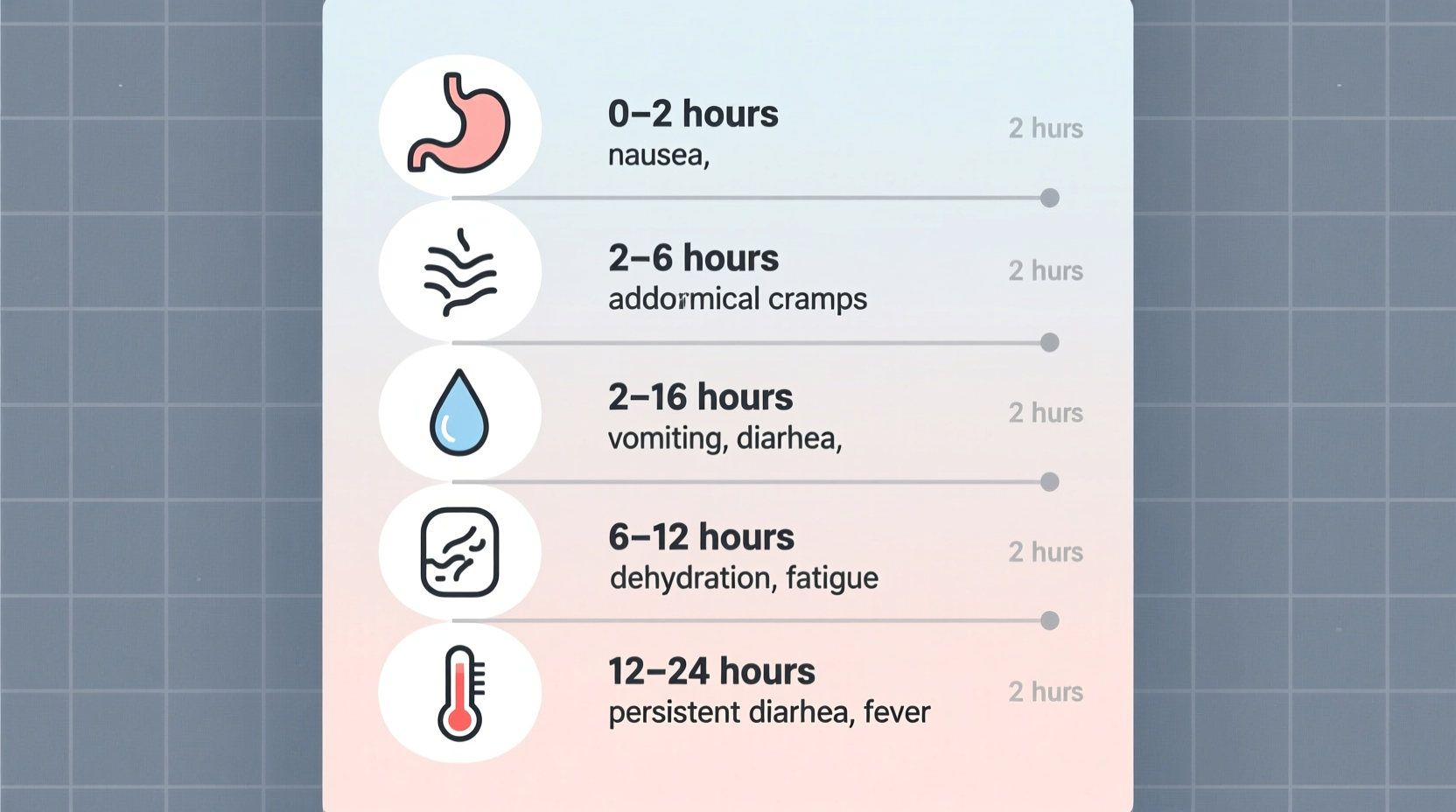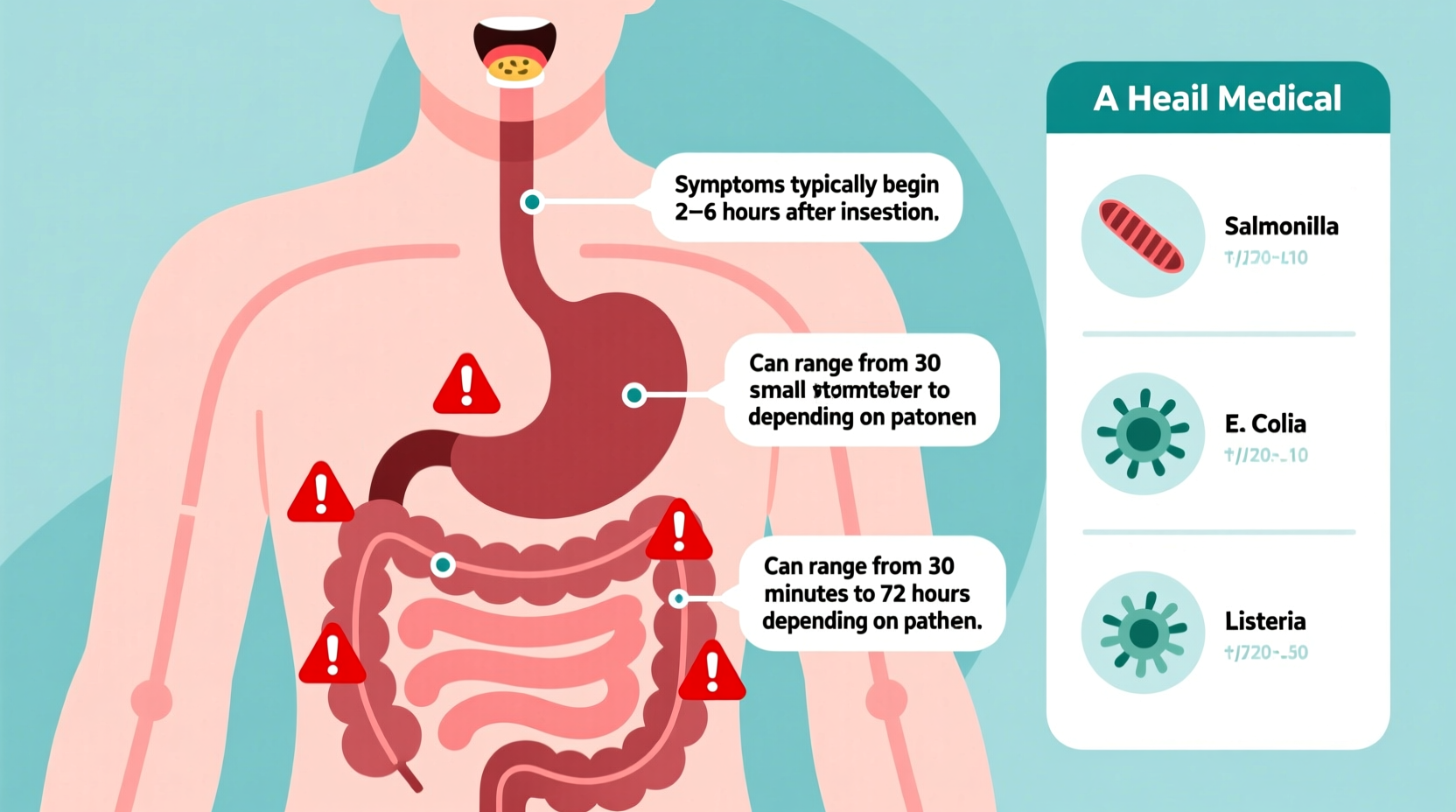Food poisoning symptoms typically appear between 30 minutes and 8 weeks after consuming contaminated food, with most common cases showing symptoms within 1-24 hours. The exact timeframe depends on the specific pathogen, your immune system, and the amount of contaminated food consumed.
When your stomach starts churning after a meal, your immediate question is likely: "How long does it take for food poisoning to hit?" Understanding the timeline can help you identify the source, determine when to seek medical help, and prevent future incidents. This guide provides evidence-based information on food poisoning onset times, backed by medical research and food safety authorities.
Food Poisoning Timeline: What to Expect
Not all foodborne illnesses strike at the same pace. The incubation period—the time between exposure and symptom onset—varies dramatically based on the contaminant. Here's what the Centers for Disease Control and Prevention (CDC) reports about common pathogens:
| Pathogen | Typical Onset Time | Common Sources | Symptom Duration |
|---|---|---|---|
| Staphylococcus aureus | 30 minutes - 8 hours | Handled foods, dairy products | 1-2 days |
| Bacillus cereus (vomiting type) | 1-6 hours | Reheated rice, pasta | 6-24 hours |
| Norovirus | 12-48 hours | Contaminated water, shellfish, salads | 1-3 days |
| Salmonella | 6-72 hours (avg 12-36) | Raw eggs, poultry, meat | 4-7 days |
| E. coli (STEC) | 1-10 days (avg 3-4) | Undercooked ground beef, raw milk | 5-10 days |
| Listeria | 1-70 days (avg 3 weeks) | Deli meats, soft cheeses, unpasteurized dairy | Variable, can be severe |
| Campylobacter | 2-5 days | Raw poultry, unpasteurized milk | 2-10 days |
This timeline from the CDC's Foodborne Outbreak Online Database System shows why identifying food poisoning can be challenging—symptoms might not appear until weeks after consuming contaminated food. Listeria, for example, has the longest incubation period, making it difficult to trace back to the source.

Why Timing Varies: Key Factors
Several elements determine how quickly food poisoning symptoms develop after exposure:
Pathogen Type and Quantity
As shown in the timeline table, different bacteria, viruses, and toxins have distinct incubation periods. The amount of pathogen you ingest also matters—consuming a larger dose often leads to faster symptom onset. According to FDA food safety guidelines, certain pathogens can cause illness with as few as 10-100 cells, while others require thousands.
Your Personal Health Factors
Your immune system strength significantly impacts symptom timing. People with compromised immunity—including older adults, young children, and those with chronic conditions—often experience symptoms sooner and more severely. Pregnant women face particular risks with Listeria, which can cross the placenta.
Food Characteristics
The type of food affects how quickly pathogens multiply and produce toxins. High-moisture, protein-rich foods like meat and dairy provide ideal breeding grounds. Acidic environments (like citrus fruits) can slow bacterial growth, potentially delaying symptoms.
When to Seek Medical Attention
While most food poisoning cases resolve without medical intervention, certain symptoms require immediate attention. Contact a healthcare provider if you experience:
- Symptoms beginning within 30 minutes of eating (possible chemical or toxin exposure)
- Blood in vomit or stool
- Signs of dehydration (dry mouth, little urination, dizziness)
- Fever above 101.5°F (38.6°C)
- Symptoms lasting more than 3 days
- Numbness, blurred vision, or muscle weakness (possible botulism)
The World Health Organization emphasizes that prompt medical attention is critical for high-risk groups, including infants, elderly individuals, and those with weakened immune systems. For suspected botulism—which has an incubation period of 12-36 hours—seek emergency care immediately as it can be life-threatening.
What Happens During the Incubation Period
Between consuming contaminated food and feeling ill, several biological processes occur:
- Ingestion: Pathogens enter your digestive system
- Survival: They must survive stomach acid to reach the intestines
- Colonization: Bacteria multiply or viruses replicate
- Toxin Production: Many pathogens release toxins that irritate the gut lining
- Symptom Onset: Your body responds with vomiting, diarrhea, and other symptoms
This explains why some food poisoning types strike quickly (those caused by pre-formed toxins like Staphylococcus), while others take days (those requiring bacterial multiplication like Salmonella).
Preventing Future Food Poisoning Incidents
Understanding food poisoning timelines helps you identify risky foods and behaviors. Implement these evidence-based prevention strategies:
Immediate Actions After a Suspected Incident
If you suspect food poisoning, note what you ate in the past 72 hours. This helps identify patterns and prevents others from consuming the same contaminated food. Report suspected restaurant-related cases to your local health department.
Short-Term Prevention (Next Meal)
- Wash hands thoroughly before handling food
- Separate raw meats from ready-to-eat foods
- Cook foods to proper internal temperatures (use a food thermometer)
Long-Term Prevention Habits
- Learn proper food storage temperatures (keep fridge below 40°F/4°C)
- Follow safe thawing practices (never thaw at room temperature)
- Replace cutting boards when heavily scratched
- Stay informed about food recalls
The FDA Food Code recommends following the "Clean, Separate, Cook, Chill" principles as the foundation of food safety. These simple steps prevent most common foodborne illnesses regardless of their incubation period.
Recovery Timeline and When You're Contagious
Most people recover from food poisoning within 1-10 days, but you may remain contagious after symptoms subside. Norovirus, for example, can be transmitted for up to two weeks after recovery. The CDC recommends staying home for at least 48 hours after symptoms end to prevent spreading illness.
During recovery, focus on rehydration with oral rehydration solutions rather than plain water. Avoid dairy, caffeine, and fatty foods until your digestive system stabilizes. Most importantly, listen to your body—rushing back to normal eating patterns can prolong recovery.











 浙公网安备
33010002000092号
浙公网安备
33010002000092号 浙B2-20120091-4
浙B2-20120091-4